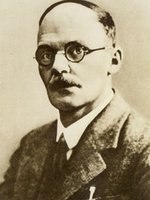










Johannes "Hans" Wilhelm Geiger was a German physicist. He is perhaps best known as the co-inventor of the Geiger counter and for the Geiger–Marsden experiment which discovered the atomic nucleus. Geiger was born at Neustadt an der Haardt, Germany. He was one of five children born to the Indologist Wilhelm Ludwig Geiger, who was professor at the University of Erlangen.
Geiger was awarded a Ph.D. by the University of Erlangen in 1906 and shortly thereafter joined the staff of the University of Manchester, where he became one of the most valuable collaborators of Ernest Rutherford. At Manchester, Geiger built the first version of his particle counter and used it and other radiation detectors in experiments that led to the identification of the alpha particle as the nucleus of the helium atom and to Rutherford’s correct proposal (1912) that, in any atom, the nucleus occupies a very small volume at the centre.
Moving in 1912 to the Physikalisch-Technische Reichsanstalt (“German National Institute for Science and Technology”) in Berlin, Geiger continued his studies of atomic structure. During World War I he served as an artillery officer in the German army. With Walther Bothe, Geiger devised the technique of coincidence counting and used it in 1924 to clarify the details of the Compton effect. In 1925 Geiger accepted his first teaching position, at the University of Kiel. There, he and Walther Müller improved the sensitivity, performance, and durability of the particle counter; the Geiger-Müller counter detects not only alpha particles but beta particles (electrons) and ionizing electromagnetic photons. In 1929 Geiger took up a post at the University of Tübingen, where he made his first observation of a cosmic-ray shower. He continued to investigate cosmic rays, artificial radioactivity, and nuclear fission after accepting a position in 1936 at the Technische Hochschule in Berlin, which he held until he died.